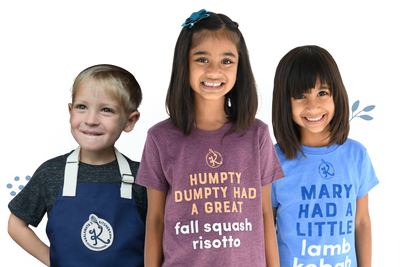
Taste Bud Profile
Meherwan Irani

Though he grew up in Maharashtra, India, Chef Meherwan Irani didn’t feel like he had a strong sense of identity or attachment to any one place or culture—a fact that he believes opened his mind and his palate at a very young age. Further inspired by his mother’s sense of hospitality and her incredible resourcefulness and creativity in the kitchen, Chef Meherwan set out to redefine the way people saw Indian food in America. His welcoming approach to food—making people feel comfortable without ever sacrificing flavor, authenticity, or experience—has won him fans all over the country, and his vibrant and joyful personality has certainly solidified his fandom on our team!



Meherwan Irani: I spent the first years of my life in London, where I was born. But most of my early food memories are from back in India. When we moved back, we lived with my grandma. She had a large estate that she had inherited from her husband, and in order to maintain it, she converted it to a Bed and Breakfast. The small, dusty town where I lived was called Ahmednagar, outside of Pune, but it was full of Westerners because there was the Meher Baba Ashram there. This was in the late 60s, early 70s, when everybody was going to India to find a guru like the Beatles did. There were several big ashrams nearby, so there were people from all over the world finding my grandma’s home as a place to stay while they visited. As a result, I did not grow up with a “normal” palate or a “normal” menu cooked at home. My mom was a Hindu Brahmin from Dehradun. So she had grown up with this very simple style of North Indian vegetarian cooking. My dad’s family is Parsi, so they’re the opposite—lots of delicious, complex meat dishes. We lived in Maharashtra, which has a cuisine that is heavy in peanuts, coconut, dried garlic and chilis, and so forth. And then we had all these foreign guests in our house. We were cooking apple pie and casseroles as much as we were eating dhansak and pulao. My mom was the unofficial chef of the house. So my earliest food memories are a bizarre melange of spaghetti and meatballs for lunch, and then dhansak and rice for dinner. One day my mom would pack me khichri to take to school, and the following day, a peanut butter and jelly sandwich. I thought this was normal, till I realized that nobody else had this kind of variation in their lunches—all the little Maharastiran boys and girls were looking at my food and going, ‘what is that? Is that even food?’ And they’re eating all this amazing khichri, and pav, and pulao, and methi bhaji and all these amazing dishes, and I just wanted to fit in. Nobody would ever exchange food with me though! But, to bring it all full circle, I think my experience of being an outsider even in my own country allowed me to develop a really global palate at a young age.

My mother was just extraordinary. When she lived in England, she learned a number of traditional English dishes, and also spent time in Italy learning how to make pasta and pizza dough from scratch. She had her family recipes from North India, and she learned how to make my father’s Parsi family recipes as well. Whenever Westerners would come to visit, she’d ask them to teach her something they liked to cook. In hindsight, she was just fearless about trying all of these things because she was never worried about whether it would be “right,” it was whether or not it would be delicious. She used what she had, and what tasted good to her to plus up what she might consider a bland dish otherwise. For example, her meatballs were basically spiced like kebabs, with a little minced garlic, onion, turmeric, and green chili. But she’d make it in a tomato sauce, and serve it with pasta, and the travelers would say it was the most flavorful version they had ever had of this dish. She was aware that many of these travelers were experiencing Indian flavors for the first time, so she integrated them into dishes that were familiar and approachable. She still transformed the dish in her use of Indian spices, Indian butter, etc.—but she made sure the guests eating it felt like they were being seen and taken care of. So when I finally started my career in cooking, I had my mom in mind.
I knew that you can transform things for the better. It’s not fusion cooking it’s just changing the approach to a traditional cuisine.
At Chai Pani, people regularly say things like, ‘why does this taste so different yet so familiar?’ And the answer is my mom. She didn’t go to college, she didn’t go to culinary school. But she mastered so many things. I didn’t realize till I was a little older that something remarkable was happening in my mom’s kitchen. Her approach is always in my mind when I consider what to put on the menu. I can’t tell you how many kids have been introduced to Indian food because of the Sloppy Jai sandwich. Tell me what kid doesn’t love a Sloppy Joe. What they’re actually eating at Chai Pani is a kheema pav, which is a 1000 year old Persian recipe that the Parsis brought with them to India. It has a world of history in it—traditionally it was a way to not waste anything. You would take off-cuts of meat and scraps, grind it up, cook the living daylights out of it with lots of spices and dairy (in this case yogurt) to break it down (which is the same technique behind bolognese by the way), and serve it with pav, which is a bread the Portuguese brought with them to India. There’s so much there, and I wanted everyone to feel like they could experience it. So instead of calling it kheema pav, I wanted to be playful and call it the Sloppy Jai. Nothing is dumbed down, nothing is changed otherwise—and thousands of kids and families have eaten it and told me that it was their entry into Indian cuisine, and that they might never have tried it if there hadn’t been something familiar to grasp on to! I didn’t do anything but remove their perceived barriers around the cuisine. The food is the same. We make it feel comfortable and approachable without taking anything away from the experience, and these kids get to travel to a different continent every time they eat it.

I went to Udvada, which is where the first Parsi Fire Temple is. And they didn’t let me in. I wasn’t wearing the proper regalia, etc. This feeling of rejection wasn’t exactly new I guess—the feeling of being an outsider in my own country was something I was used to from my childhood. I wasn’t Parsi, I wasn’t Hindu, I wasn’t Maharashtrian. Hindi was not my first language. When you’re Indian, you often have a very strong sense of identity around your region, your food, your language, your religion. I had no sense of that identity.
But what seemed like failure to fit in when I was a kid actually made me a more global Indian earlier than even your average 1st, 2nd, or 3rd generation Indian immigrant.
When I came to the US, I already had this sensibility baked in—two worlds had already collided, and I didn’t really have to worry about trying to tell just one personal Indian story. I picked the most pan-Indian cuisine of them all, the things that are ubiquitous in their own forms all over India. Who can lay strict claim to bhel puri or vada pav? What religion can say, ‘pakoras are ours’? Nobody! That’s where my comfort zone was—I’m actually a mix of so many experiences, and nobody can confine me to just one. My younger sense of being an outsider in my own country helped me shape how I cook, what I can present, how to approach people, and how to remove the barriers we all erect between various cultures. I can see how it helps my daughter, who is a second generation Indian, when she goes to India and doesn’t feel like she belongs. I can help her navigate her American side and her Indian side because I can relate to how she feels. I have felt that way too. In my restaurants, I want everyone to feel welcome, including non-Indians who can come in and say, ‘whoever runs this place can relate to our experience of being in an unfamiliar space for the first time too.’

My advice is less for kids and more for parents. Just make things fun and approachable. There’s no reason that your kid won’t love pad Thai or khichri as much as they love spaghetti and meatballs—it all depends on how you introduce them. A dish from another culture can be authentic without being unapproachable, and it can be delicious without being dumbed down somehow. Just let them try it, and make sure you try it too with an open mind.

